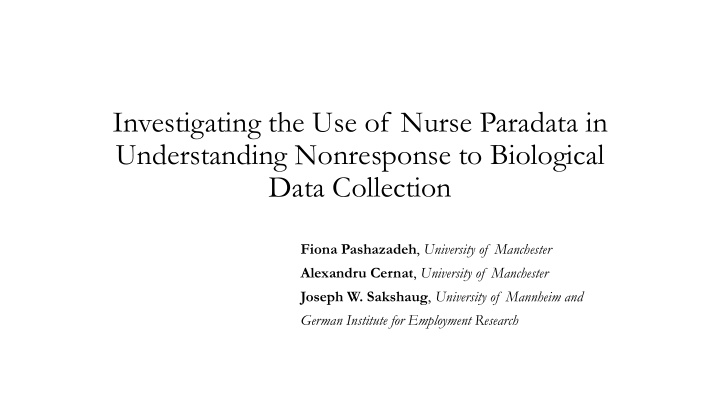



Investigating the Use of Nurse Paradata in Understanding Nonresponse to Biological Data Collection Fiona Pashazadeh , University of Manchester Alexandru Cernat , University of Manchester Joseph W. Sakshaug , University of Mannheim and German Institute for Employment Research
Bio-social surveys have a great potential Combining the advantages from both data • “Representative” samples • Info on social background • “Objective” health measures • Wealth of biological measures
Examples of such surveys Health and Retirement Study SHARE/English Longitudinal Study of Ageing UKHLS Health Survey for England
Models for data collection 1. Interviewer biological data collection 2. Nurse home visit 3. Hospital visit
Issue with this type of data collection • Nurse visit can be burdensome and intrusive • Multiple stages of missing data
Example of missing data patterns
Nurse also can have an important role in data collection
Nurse impact on measurement error
Can paradata help use understand nurse behaviour?
Can paradata help us understand the nurse non-response? 1. What types of paradata is available from the nurse visits? 2. What is the quality of the available paradata ? 3. Can paradata variables improve existing models of nonresponse?
Data used - Understanding Society One of the largest longitudinal studies in the world Collected biological data in waves 2 and 3 Wealth of methodological data
Data collection process Main wave interview Six months latter contact regarding a nurse visit Big proportion had appointments made in advance
Potential paradata to use • Contact sequence and type • Contact and interview length • Nurse observations • Estimates from statistical models
Missing data in call record Stage of biological data Number of eligible Number with call Number with missing Percentage with call collection individuals record data call record data record data Wave 2 1) Nurse visit 21161 18408 2753 86.99% 2) Consent to the blood 14264 14196 68 99.52% sample 3) Obtaining blood 11018 10965 53 99.52% sample given consent Wave 3 1) Nurse visit 6604 5779 825 87.51% 2) Consent to the blood 4857 4845 12 99.75% sample 3) Obtaining blood 3741 3732 9 99.76% sample given consent
Distribution of response times 5000 Histogram of total nurse visit time in minutes 4000 4000 3000 3000 Frequency Frequency 2000 2000 1000 1000 0 0 0 20 40 60 80 100 120 140 0 50 100 150 Total nurse visit time minus the blood sample modules in minutes Total nurse visit time in minutes
Nurse characteristics and paradata used Variable Description Nurse age Nurse characteristics Nurse years of experience working for NatCen Suspicious Nurse observation Non-cooperative "No reply", "Contact made", "Appointment made", "Any interviewing done", "Any Outcome of first call to the household other status", “Missing” Time in minutes of main survey interview Main interview length Time in minutes to complete the nurse visit Length of nurse visit excluding the blood excluding all blood sample components sample (stages 2 and 3)
Developing nurse performance indicators
Regression models explaining three stages of participation wave 2 Nurse visit: • Non-cooperation & Suspicious • Nurse age • Positive first visit outcome • Missing paradata Consent: • Suspicious • Main interview and start of nrs. interview length Collecting blood • Non-cooperative • Main interview length
Regression models explaining three stages of participation wave 3 Nurse visit: • Positive first visit outcome • Missing paradata • Nurse performance (prev. wave) Consent: • Suspicious Collecting blood
Conclusions Large(r) amounts of missing paradata Less variation than normal interview in contact seq. Some differences between the effects on the two data Models for nurse visit more useful Low predictive power
Useful variables to use in the future • Nurse observations • First outcome • Time latencies • Missing indicator • Nurse performance
You the guy who donated his body to science?
Understanding Nurse Paradata and Nonresponse Alexandru Cernat @cernat_a www.alexcernat.com
Recommend
More recommend